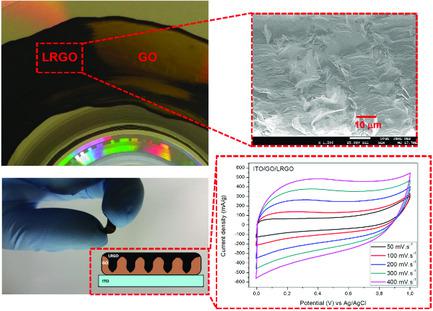当前位置:
X-MOL 学术
›
Phys. Status Solidi A
›
论文详情
Our official English website, www.x-mol.net, welcomes your
feedback! (Note: you will need to create a separate account there.)
Laser Reduction of Graphene Oxide/Zinc Oxide Nanoparticle Nanocomposites as a One‐Step Process for Supercapacitor Fabrication
Physica Status Solidi (A) - Applications and Materials Science Pub Date : 2020-04-24 , DOI: 10.1002/pssa.201901046 Afonso Gabriel dos Anjos Júnior 1, 2 , Gabriel Pimenta de Freitas Cardoso 1 , Leonardo Giordano Paterno 3 , Artemis Marti Ceschin 1
Physica Status Solidi (A) - Applications and Materials Science Pub Date : 2020-04-24 , DOI: 10.1002/pssa.201901046 Afonso Gabriel dos Anjos Júnior 1, 2 , Gabriel Pimenta de Freitas Cardoso 1 , Leonardo Giordano Paterno 3 , Artemis Marti Ceschin 1
Affiliation

|
Herein, the laser reduction of graphene oxide (GO) and zinc oxide nanoparticle (ZnONP) nanocomposite films is proposed as a one‐step process for supercapacitor fabrication. The films, deposited by casting onto a flexible poly(ethylene terephthalate) (PET) substrate coated with indium‐doped tin oxide (ITO), are subjected to laser irradiation (5 mW, 405 nm) to reduce the GO phase and produce laser‐reduced GO (LRGO). Scanning electron microscopy/energy dispersion spectroscopy (SEM–EDS), micro‐Raman spectroscopy, and current versus voltage (I × V ) analyses show a partial reduction of GO to LRGO, forming several conductor‐insulating (LRGO/GO) microporous interfaces, and thereby favoring the formation of a supercapacitor structure. Moreover, the topmost LRGO film layer is extensively reduced, making it sufficiently conducting to work as the counter electrode as well. However, the reduction process is less effective when ZnONPs are introduced into the GO matrix because ZnONPs get clustered and scatter the incident laser before reaching the GO phase. The capacitive behavior, assessed by cyclic voltammetry and galvanostatic charge–discharge measurements, reveals the following specific capacitances: 2.68 F g−1 (GO/LRGO) and 1.44 F g−1 (GO/LRGO/ZnONP). The method proposed herein is advantageous because it produces the microcapacitor structures and LRGO counter electrode in a single laser reduction step.
中文翻译:

激光还原氧化石墨烯/氧化锌纳米颗粒纳米复合材料作为一步法制造超级电容器
在本文中,提出了激光还原氧化石墨烯(GO)和氧化锌纳米颗粒(ZnONP)纳米复合膜作为超级电容器制造的一步法。通过流延到涂有掺铟锡氧化物(ITO)的柔性聚对苯二甲酸乙二醇酯(PET)基底上来沉积薄膜,然后对其进行激光照射(5 mW,405 nm)以减少GO相并产生激光。降低GO(LRGO)。扫描电子显微镜/能谱仪(SEM-EDS),显微拉曼光谱仪以及电流与电压的关系(I × V)分析表明,GO会部分还原为LRGO,形成几个导体绝缘(LRGO / GO)微孔界面,从而有利于超级电容器结构的形成。此外,最上层的LRGO薄膜层被大量减少,使其足够导电,从而也可以用作对电极。但是,将ZnONPs引入GO矩阵时,还原过程的效果较差,因为ZnONPs会聚簇并在到达GO相之前散射入射激光。通过循环伏安法和恒电流充放电测量评估的电容行为揭示了以下比电容:2.68 F g -1(GO / LRGO)和1.44 F g -1(GO / LRGO / ZnONP)。本文提出的方法是有利的,因为它在单个激光还原步骤中产生了微电容器结构和LRGO对电极。
更新日期:2020-04-24
中文翻译:

激光还原氧化石墨烯/氧化锌纳米颗粒纳米复合材料作为一步法制造超级电容器
在本文中,提出了激光还原氧化石墨烯(GO)和氧化锌纳米颗粒(ZnONP)纳米复合膜作为超级电容器制造的一步法。通过流延到涂有掺铟锡氧化物(ITO)的柔性聚对苯二甲酸乙二醇酯(PET)基底上来沉积薄膜,然后对其进行激光照射(5 mW,405 nm)以减少GO相并产生激光。降低GO(LRGO)。扫描电子显微镜/能谱仪(SEM-EDS),显微拉曼光谱仪以及电流与电压的关系(I × V)分析表明,GO会部分还原为LRGO,形成几个导体绝缘(LRGO / GO)微孔界面,从而有利于超级电容器结构的形成。此外,最上层的LRGO薄膜层被大量减少,使其足够导电,从而也可以用作对电极。但是,将ZnONPs引入GO矩阵时,还原过程的效果较差,因为ZnONPs会聚簇并在到达GO相之前散射入射激光。通过循环伏安法和恒电流充放电测量评估的电容行为揭示了以下比电容:2.68 F g -1(GO / LRGO)和1.44 F g -1(GO / LRGO / ZnONP)。本文提出的方法是有利的,因为它在单个激光还原步骤中产生了微电容器结构和LRGO对电极。











































 京公网安备 11010802027423号
京公网安备 11010802027423号